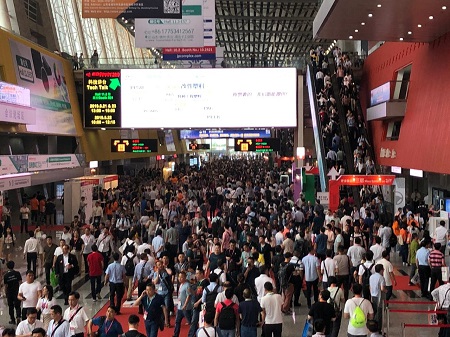CHINAPLAS, now on a par with K Show in Germany, had a successful run in Guangzhou from May 21-24. The exhibition featured 3,500+ exhibitors from around the world. The exhibition attracted 163,314 visitors with 42,005 or 25.7% coming from outside China, a strong indication of how the CHINAPLAS has become the growth driver in the Asian region’s plastics industry. The whole show floor was alive with machine demonstrations and lively discussions among visitors and exhibitors.
This mega trade show addressed the world’s most pressing issues on the production and use of plastics through its various concurrent events and main highlights. Smart manufacturing technologies & equipment, green & circular solutions to plastics production, and innovative high-performance materials were shown prominently in the 250,000 square meters of exhibition space. With its theme “Innovation is Key to the Future”, CHINAPLAS placed emphasis on the developments in the application of plastics in a wide range of industries such as automotive, packaging, medical, communications, building & construction.

In response to the global trend, a concurrent event called “Industry 4.0 Factory of the Future”, with major players in Industry 4.0, including iPlast 4.0, EUROMAP and Germany’s VDMA were organised with two themed areas –– “Manufacturing Intelligence Control Room” and “Smart Factory” –– which demonstrated intelligent solutions in real-life settings with a daily display of 15 scenarios related to production shop floor, business operations and supply chain management under Industry 4.0 protocols. CHINAPLAS 2019 also teamed up with the Guangdong Industrial Design Association for the event “Design x Innovation”, which comprised of three parts – “CMF Inspiration Walls”, “Design Forum” and “CHINAPLAS Designers’ Night”.
This year, the exhibition identified 10 new materials highlights and 10 processing technologies highlights that will surely define the future of plastics manufacturing. The top 10 new materials highlights include: Fibre-reinforced composites; Lightweight materials for new energy vehicles; Highly functional materials for 5G telecommunications; Graphene-based electrically conductive plastics; Medical grade plastics & silicon rubber with clean, transparent, chemical-resistant properties; High-performance thermoplastic elastomer; Degradable, bio-based and recyclable materials; Additives to reduce VOC emission, change color & brightness; Liquid additives & masterbatches; and New eco-friendly and specialty plastics for 3D printing.
The top 10 processing technologies highlights include: Industry 4.0, digital manufacturing solutions; Cost-effective and high-quality small batch, diversified production; Automatic all-in-one machines; LSR injection moulding technology; Multi-layer injection/multi-layer co-extrusion technologies; All-electric extrusion blow moulding machines; Specialised high-quality film technology; In-mould decoration technologies, combination of PU in-mold coating and flexible manufacturing technology; Recycling Technologies; and Extrusion machinery for medical industry.














